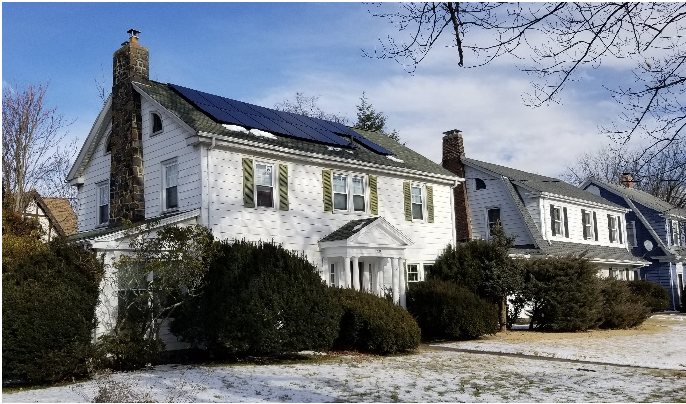Solar Energy
For centuries, “passive” solar design and construction techniques have been used to collect, store, and release heat from the sun. Many historic buildings include passive solar features that should be retained and even enhanced. Such building features often include strategic orientation toward the sun, large windows on south-facing walls, and masonry walls and floors that store and distribute solar heat. Initial attempts to harness solar energy were made in the late nineteenth century, but it was not until the 1950s that solar cells were developed for residential use. With fossil fuel shortages in the 1970s the idea of photovoltaic panel (PV) technology became popular. In 1977 the federal government created the National Renewable Energy Laboratory (NREL) to further the development of solar technology. In the 1990s the discovery of new materials improved solar efficiency and reduced solar panel thickness and weight, increasing their popularity. In recent decades innovations have been made to further improve PV panel efficiency and appearance, making it easier to reduce their impact on historic buildings. The current life expectancy for PV panels is about 25 to 30 years.
There are two major types of solar collectors: photovoltaic panels and building-integrated photovoltaics (BIPV). PV cells contain semiconducting material such as silicon. When sunlight is absorbed by a semiconductor, the electrons within the material are let loose. The flow of electrons creates a current of electricity. An inverter transforms the direct current (DC) into alternating current (AC), and excess electricity generation is stored in the grid. Thanks to Connecticut’s Net Meter Law, any excess energy sent back to the grid must be purchased by the local power company at full retail rate.
PV systems work best in areas where they will be exposed to at least six hours of sun a day. Typically, BIPV systems are less visually intrusive. Some technologies now allow PV collectors to be hidden entirely within the roof structure. However, this technology is still new, and is not as efficient as conventional PV panels.
If your property is located in a Local Historic District, be sure to coordinate with the LHDC at an early date to reduce the possibility of project delays. Chapter 97, Sec. 7-147f of the Connecticut statutes prohibits a commission from denying an application for a certificate of appropriateness for a “solar energy system designed for the utilization of renewable resources” unless “the commission finds that the feature cannot be installed without substantially impairing the historic character and appearance of the district.” The commission can impose conditions on the issuance of the certificate of appropriateness, including design modification and limitations on the location of the feature, provided that the effectiveness of the system is not significantly impaired.
The National Park Service has acknowledged that photovoltaic panels help to enhance the energy efficiency of historic buildings, but they should be installed in a sensitive manner:
• Install in visually unobtrusive ground-mount arrays, if possible.
• Use vegetation or a compatible screen to further reduce the visual impact of installations.
• If ground-mounted installations are infeasible, site roof-mounted arrays with either no or minimal visibility from nearby streets, sidewalks or public spaces.
• Avoid altering the historic character of the building.
• Avoid damaging historic roof materials.
The National Park Service provides examples based on installation:
Installing Solar Panels and Meeting the Secretary of the Interior's Standards
Incorporating Solar Panels in a Rehabilitation Project1
Solar Panel Placement
Ideal solar panel locations will have no physical impact on the primary structure and negligible visual impact on the site as a whole. Visibility is the biggest concern when introducing a solar collection system on or near a historic building. Solar panel locations and methods are described below, in order of least to greatest impacts on historic properties.2
Ground- or pole-mounted arrays. These options are preferred because they do not impact historic buildings, and they are easily reversible. If installed in a side or rear yard, they can be even less inconspicuous when they are sited carefully. For instance, if a farmhouse has sweeping views of a nearby field, install the array on the opposite side to preserve the visual continuity of the house and associated property. Arrays should be close to the ground and screened with plantings, whenever possible, to limit visibility.
New construction or additions. Installing solar panels on a new or non-historic accessory building, such as a garage, provided it is compatible in design, avoids direct impact to a historic building. Even on new construction, panels should be placed on rear or side elevations.
On historic buildings - Roof-mounted solar panels. Roof mounts are the most common types of installations, and they can often be accomplished sensitively. Be sure that the installation is not visible, or only minimally visible, from the public view, with panels on side or rear roof slopes. Optimal placement is on a nonpublic facing slope. Installations should match the basic slope and color of the existing roof, and the panel profile should be as low as possible. The installation should not damage historic roofing materials. On flat roofs, panels should be set back to screen them from street view. Roof structures may require repairs or reinforcements to support the weight of a solar panel system.
1 https://www.nps.gov/tps/standards/applying-rehabilitation/its-bulletins/ITS52-SolarPanels.pdf
2 Illustration of solar panel placements in this section are courtesy of Sustainable Preservation: An Addendum to Building with Nantucket in Mind by Ginny Way.
Do: Place panels on a nonpublic facing slope
Don’t: Place panels on façade
Solar roof shingles. These are less visually obtrusive than traditional PV panels, but their installation can have a greater impact on historic building materials. For instance, each solar shingle requires a screw into the sub-roofing. Currently, solar roof shingles are not generally as efficient as conventional PV panels, but solar technology is progressing at a rapid pace and new products are being produced each year.
Solar thermal systems. These systems, typically roof-mounted, harness the power of the sun to heat liquids for specific applications. They are similar in appearance to PV panels. They are used to provide hot water, space heating, cooling, and pool heating for residential, commercial, and industrial applications. The sun’s energy heats a fluid in the solar collectors, and the heated fluid passes through a heat exchanger in a storage tank, transferring heat to water. The fluid is cycled back to the collectors. Installation of solar thermal panels should follow the same guidelines used for PV panels, and exterior storage tanks should be placed in a rear or side yard and appropriately screened from view.
Most electrical plants in Connecticut are powered by fossil fuels. Every new solar energy system placed into service works directly to reduce harmful emissions. By understanding and minimizing potential impacts to historic materials, historic building owners can do their part to work toward reduction in fossil fuel consumption.
Common Terms Used in Solar Installations
Active System – A solar system that uses mechanical and electrical equipment to collect, store, and transport solar energy. Examples include photovoltaic and solar thermal systems.
Array – A set of connected photovoltaic modules or panels that function as a unit.
Cell – The smallest component of a solar panel, which converts sunlight into electricity.
Electrical Grid – The system in a discrete geographical area that distributes electricity to buildings, structures, and sites. A “grid-connected” solar energy system uses the grid as a backup power source. In Connecticut, service providers are required to purchase any excess power generated by residential solar systems.
Inverter – The device used to convert direct current (DC) into alternating current (AC).
Mount – Method of attaching solar panels to the roof or ground.
Net Meter – An electrical meter that spins both forward and backward, depending upon whether electricity is flowing in or out of the grid.
Passive Solar System – Collecting and storing solar heat through building siting, design, and materials rather than technological systems.
Photovoltaic (PV) System – Technology that converts solar energy into electrical energy.
Solar Module – Several connected solar cells; also called a solar panel; usually measuring several feet per side.
Solar Panel – several connected solar cells; a general term for the discrete unit of a system that captures solar energy, usually measuring several feet per side; sometimes also called a solar module.
Solar thermal systems – systems that produce heat by using sunlight to heat water or another fluid such as antifreeze.
Tilt – the angle of a solar panel arranged optimally to collect the most sunlight.
Tracking panels – panels that change orientation to follow the sun’s path.





